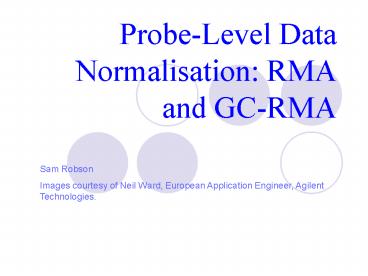Probe-Level Data Normalisation: RMA and GC-RMA - PowerPoint PPT Presentation
1 / 25
Title:
Probe-Level Data Normalisation: RMA and GC-RMA
Description:
Probe-Level Data Normalisation: RMA and GC-RMA Sam Robson Images courtesy of Neil Ward, European Application Engineer, Agilent Technologies. References Summaries ... – PowerPoint PPT presentation
Number of Views:100
Avg rating:3.0/5.0
Title: Probe-Level Data Normalisation: RMA and GC-RMA
1
Probe-Level Data Normalisation RMA and GC-RMA
Sam Robson Images courtesy of Neil Ward, European
Application Engineer, Agilent Technologies.
2
References
- Summaries of Affymetrix Genechip Probe Level
Data, Irizarry et al., Nucleic Acids Research,
2003, Vol. 31, No. 4. - Exploration, Normalization and Summaries of High
Density Oligonucleotide Array Probe Level Data,
Irizarry et al., - A Model Based Background Adjustment for
Oligonucleotide Expression Arrays, Wu, Irizarry
et al., Johns Hopkins University, Dept. of
Biostatistics
3
Affymetrix Genechips
- Each gene represented by 11-20 probe pairs.
- Probe pairs are 3 biased.
- Probe Pair consists of Perfect Match (PM) and
MisMatch (MM) probes. - MM has altered middle (13th) base. Designed to
measure non-specific binding (NSB).
4
Genechip Scanning
- RNA sample prepared, labelled and hybridised to
chip. - Chip fluorescently scanned. Gives a raw pixelated
image - .DAT file. - Grid used to separate pixels related to
individual probes. - Pixel intensities averaged to give single
intensity for each probe - .CEL file. - Probe level intensities combined for each probe
set to give single intensity value for each gene.
5
Affymetrix MicroArray Suite (MAS) v4.0
- Uses MM probes to correct for NSB.
- MAS4.0 used simple Average Difference method
- A is the subset of probes where is
within 3 SDs of the average of - Excludes outliers, but not a robust averaging
method.
6
Affymetrix MicroArray Suite (MAS) v5.0
- Current method employed by Affymetrix.
- Weighted mean using one-step Tukey Biweight
Estimate - CTj is a quantity derived from MMj never larger
than PMj. - Weights each probe intensity based on its
distance from the mean. - Robust average (insensitive to small changes from
any assumptions made).
7
Tukey Biweight
8
Problems with Mis-Match data
- MM intensity levels are greater than PM intensity
levels in 1/3 of all probes. - Suggests that MM probes measure actual signal,
and not just NSB. - Removal of MM results in negative signal values.
- Subtracting MM data will result in loss of
interesting signal in many probes. Several
methods have been proposed using only PM data.
9
Problems with Mis-Match data
10
Problems with MAS5.0
- Loss of probe-level information.
- Background estimate may cause noise at low
intensity levels due to subtraction of MM data.
11
Robust Multiarray Average (RMA)
- Subtraction of MM data corrects for NSB, but
introduces noise. - Want a method that gives positive intensity
values. - Normalising at probe level avoids the loss of
information.
12
Robust Multiarray Average (RMA)
- Background correction.
- Normalization (across arrays).
- Probe level intensity calculation.
- Probe set summarization.
13
Robust Multiarray Average (RMA)
- PM data is combination of background and signal.
- Assume strictly positive distribution for signal.
Then background corrected signal is also
positively distributed. - Background correction performed on each array
seperately.
14
Robust Multiarray Average (RMA)
- Background correction.
- Normalization (across arrays).
- Probe level intensity calculation.
- Probe set summarization.
15
Robust Multiarray Average (RMA)
- Normalises across all arrays to make all
distributions the same. - Quantile Normalization used to correct for
array biases. - Compares expression levels between arrays for
various quantiles. - Can view this on quantile-quantile plot.
- Protects against outliers.
16
Robust Multiarray Average (RMA)
- Background correction.
- Normalization (across arrays).
- Probe level intensity calculation.
- Probe set summarization.
17
Robust Multiarray Average (RMA)
- Linear model.
- Uses background corrected, normalised, log
transformed probe intensities (Yijn). - µin Log scale expression level (RMA measure).
- ajn Probe affinity affect.
- eijn Independent identically distributed
error term (with mean 0).
18
Robust Multiarray Average (RMA)
- Background correction.
- Normalization (across arrays).
- Probe level intensity calculation.
- Probe set summarization.
19
Robust Multiarray Average (RMA)
- Combine intensity values from the probes in the
probe set to get a single intensity value for
each gene. - Uses Median Polishing.
- Each chip normalised to its median.
- Each gene normalised to its median.
- Repeated until medians converge.
- Maximum of 5 iterations to prevent infinate loops.
20
Robust Multiarray Average (RMA)
- Pre-Normalisation
21
Robust Multiarray Average (RMA)
- Post-Normalisation
22
GC-RMA
- Corrects for background noise as well as NSB.
- Probe affinity calculated using position
dependant base effects - MM data adjusted based on probe affinity, then
subtracted from PM. - Does not lose MM data.
23
Advantages of RMA/GC-RMA
- Gives less false positives than MAS5.0.
- See less variance at lower expression levels than
MAS5.0. - Provides more consistent fold change estimates.
- Exclusion of MM data in RMA reduces noise, but
loses information. - Inclusion of adjusted MM data in GC-RMA reduces
noise, and retains MM data.
24
Disadvantages of RMA/GC-RMA
- May hide real changes, especially at low
expression levels (false negatives). - Makes quality control after normalisation
difficult. - Normalisation assumes equal distribution which
may hide biological changes.
25
Conclusions
- RMA is more precise than MAS5.0, but may result
in false negatives at low expression levels. - Useful for fold change analysis, but not for
studying statistical significance. Makes quality
control difficult. - Ideal solution Use standard MAS5.0 techniques
for quality control. Then go back and perform
probe level normalisation on quality controlled
genes.































